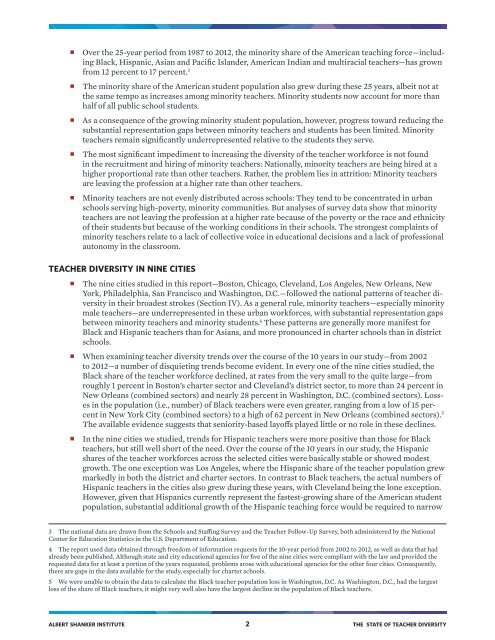TEACHER DIVERSITY
The State of Teacher Diversity_0
The State of Teacher Diversity_0
- No tags were found...
You also want an ePaper? Increase the reach of your titles
YUMPU automatically turns print PDFs into web optimized ePapers that Google loves.
■■<br />
■■<br />
■■<br />
■■<br />
■■<br />
Over the 25-year period from 1987 to 2012, the minority share of the American teaching force—including<br />
Black, Hispanic, Asian and Pacific Islander, American Indian and multiracial teachers—has grown<br />
from 12 percent to 17 percent. 3<br />
The minority share of the American student population also grew during these 25 years, albeit not at<br />
the same tempo as increases among minority teachers. Minority students now account for more than<br />
half of all public school students.<br />
As a consequence of the growing minority student population, however, progress toward reducing the<br />
substantial representation gaps between minority teachers and students has been limited. Minority<br />
teachers remain significantly underrepresented relative to the students they serve.<br />
The most significant impediment to increasing the diversity of the teacher workforce is not found<br />
in the recruitment and hiring of minority teachers: Nationally, minority teachers are being hired at a<br />
higher proportional rate than other teachers. Rather, the problem lies in attrition: Minority teachers<br />
are leaving the profession at a higher rate than other teachers.<br />
Minority teachers are not evenly distributed across schools: They tend to be concentrated in urban<br />
schools serving high-poverty, minority communities. But analyses of survey data show that minority<br />
teachers are not leaving the profession at a higher rate because of the poverty or the race and ethnicity<br />
of their students but because of the working conditions in their schools. The strongest complaints of<br />
minority teachers relate to a lack of collective voice in educational decisions and a lack of professional<br />
autonomy in the classroom.<br />
<strong>TEACHER</strong> <strong>DIVERSITY</strong> IN NINE CITIES<br />
■■<br />
The nine cities studied in this report—Boston, Chicago, Cleveland, Los Angeles, New Orleans, New<br />
York, Philadelphia, San Francisco and Washington, D.C.—followed the national patterns of teacher diversity<br />
in their broadest strokes (Section IV). As a general rule, minority teachers—especially minority<br />
male teachers—are underrepresented in these urban workforces, with substantial representation gaps<br />
between minority teachers and minority students. 4 These patterns are generally more manifest for<br />
Black and Hispanic teachers than for Asians, and more pronounced in charter schools than in district<br />
schools.<br />
■■<br />
When examining teacher diversity trends over the course of the 10 years in our study—from 2002<br />
to 2012—a number of disquieting trends become evident. In every one of the nine cities studied, the<br />
Black share of the teacher workforce declined, at rates from the very small to the quite large—from<br />
roughly 1 percent in Boston’s charter sector and Cleveland’s district sector, to more than 24 percent in<br />
New Orleans (combined sectors) and nearly 28 percent in Washington, D.C. (combined sectors). Losses<br />
in the population (i.e., number) of Black teachers were even greater, ranging from a low of 15 percent<br />
in New York City (combined sectors) to a high of 62 percent in New Orleans (combined sectors). 5<br />
The available evidence suggests that seniority-based layoffs played little or no role in these declines.<br />
■■<br />
In the nine cities we studied, trends for Hispanic teachers were more positive than those for Black<br />
teachers, but still well short of the need. Over the course of the 10 years in our study, the Hispanic<br />
shares of the teacher workforces across the selected cities were basically stable or showed modest<br />
growth. The one exception was Los Angeles, where the Hispanic share of the teacher population grew<br />
markedly in both the district and charter sectors. In contrast to Black teachers, the actual numbers of<br />
Hispanic teachers in the cities also grew during these years, with Cleveland being the lone exception.<br />
However, given that Hispanics currently represent the fastest-growing share of the American student<br />
population, substantial additional growth of the Hispanic teaching force would be required to narrow<br />
3 The national data are drawn from the Schools and Staffing Survey and the Teacher Follow-Up Survey, both administered by the National<br />
Center for Education Statistics in the U.S. Department of Education.<br />
4 The report used data obtained through freedom of information requests for the 10-year period from 2002 to 2012, as well as data that had<br />
already been published. Although state and city educational agencies for five of the nine cities were compliant with the law and provided the<br />
requested data for at least a portion of the years requested, problems arose with educational agencies for the other four cities. Consequently,<br />
there are gaps in the data available for the study, especially for charter schools.<br />
5 We were unable to obtain the data to calculate the Black teacher population loss in Washington, D.C. As Washington, D.C., had the largest<br />
loss of the share of Black teachers, it might very well also have the largest decline in the population of Black teachers.<br />
ALBERT SHANKER INSTITUTE 2 THE STATE OF <strong>TEACHER</strong> <strong>DIVERSITY</strong>


